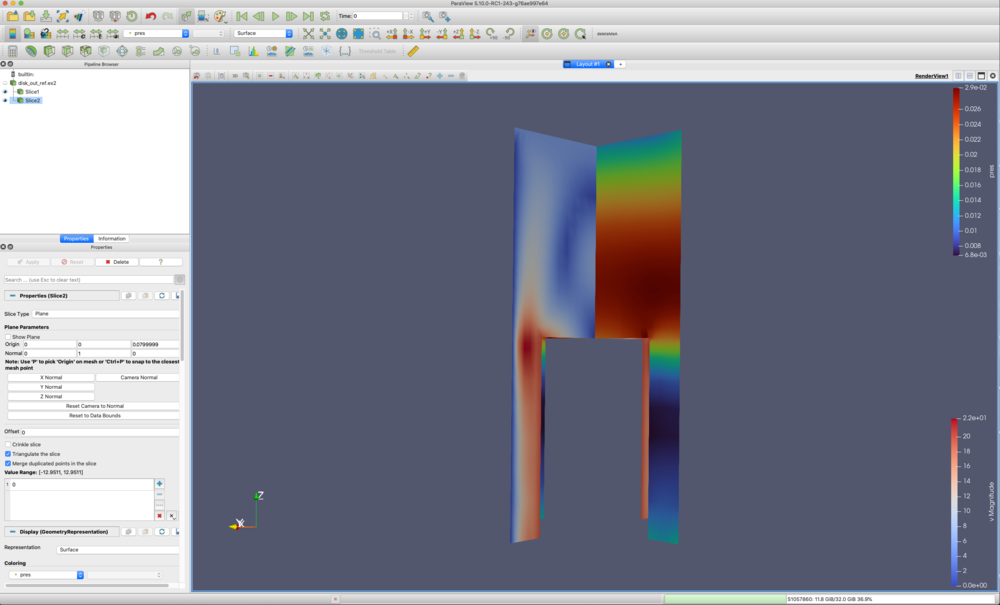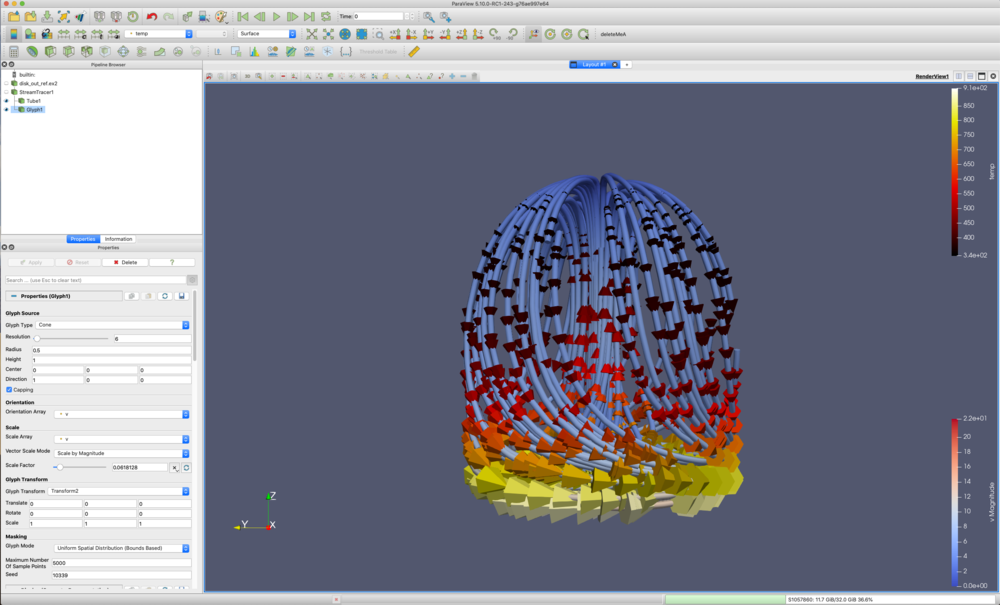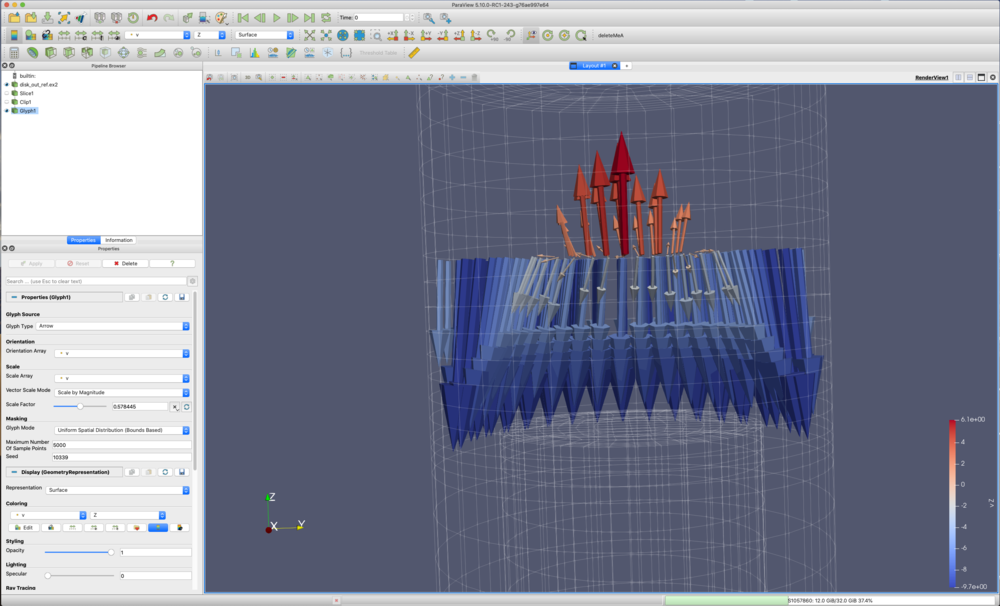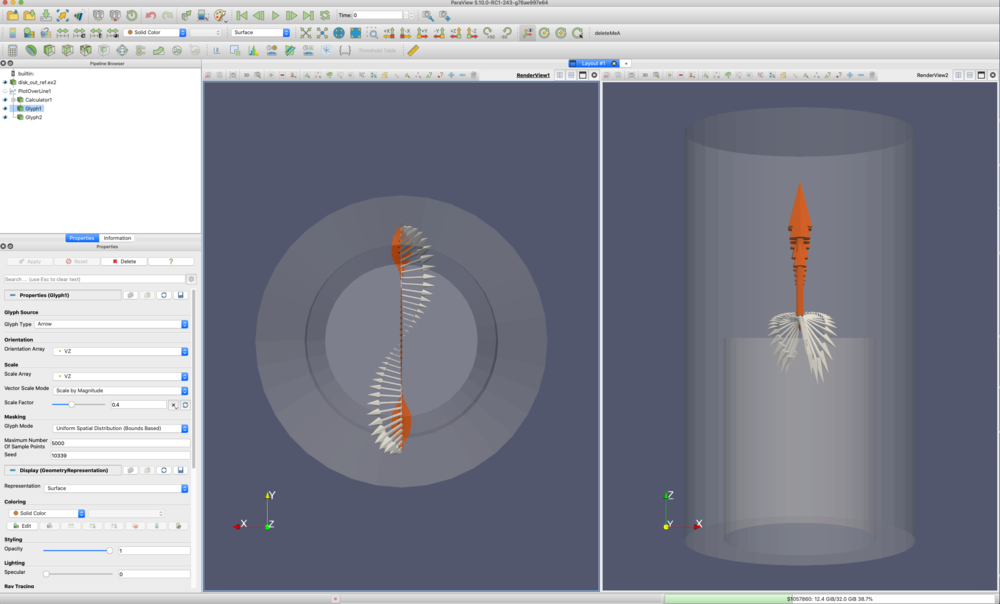Computational Fluid Dynamics: Difference between revisions
m (Wascott moved page ParaView and Computational Fluid Dynamics to Computational Fluid Dynamics: Original name was verbose. Fixig that.) |
|||
| Line 61: | Line 61: | ||
==Flow in a fluid== | ==Flow in a fluid== | ||
To show a velocity profile we need to sample the dataset with a line, and then create glyphs off of this line. This can be done using a trick in ParaView, i.e., the Plot over Line filter. Note that a Resample to Line filter will be added in ParaView 5.11 or so. | |||
*'''File → Open → Examples → disk_out_ref.exo.'''. On the '''Properties''' tab, click '''Apply'''. | |||
Lets sample over a line. | |||
*'''Filters → Data Analysis → Plot over Line'''. '''Y Axis'''. Change the '''Z''' component of the line to '''1'''. Change the '''Resolution''' to '''40'''. '''Apply'''. | |||
*Close the '''LineChartView'''. | |||
*In the '''Pipeline Browser''', turn visibility off for '''disk_out_ref.exo'''. | |||
We now have a line sampled through the fluid. Lets calculate the negative Z component of V (so it goes the opposite direction on the line from V). That way we can have two profiles, one with V, and one with Vz. | |||
*'''Filters → Common → Calculator'''. Change '''Result''' to '''Vz'''. Use '''0*iHat+0+jHat+-v_Z*kHat''' for the formula. '''Apply'''. | |||
Now we want to create two Glyphs - one from the '''Calculator''' filter, and one directly from the '''Plot over Line''' filter. | |||
*The '''Calculator''' filter should still be highlighted in the Pipeline Browser. | |||
*'''Filters → Common → Glyph'''. '''Glyph Type: Arrow'''. '''Orientation Array: Vz'''. '''Scale Array: Vz '''. '''Very Important - Scale Factor''' select the recycle button to the right. '''.5X'''. '''.5X'''. '''Apply'''. | |||
*Click on the '''Color Editor''' icon. Change the color to Orange. '''Apply'''. | |||
*In the Pipeline Browser select the '''Plot over Line''' filter. | |||
*'''Filters → Common → Glyph'''. '''Glyph Type: Arrow'''. '''Orientation Array: v'''. '''Scale Array: v '''. '''Very Important - Scale Factor''' select the recycle button to the right. '''Apply'''. | |||
Let's put these glyphs back into context by showing the original dataset. | |||
*Select '''disk_out_ref.exo''' in the Pipeline Browser. On the Properties tab, change '''Opacity''' to '''0.3'''. | |||
Just to create a nice image, I'm going to split the views horizontally, and show this visualization also from the side. | |||
[[Image:cfd_fluid_velocity_profile1.png|1000px]] | |||
==Gradient and Curl== | ==Gradient and Curl== | ||
Revision as of 02:25, 13 November 2021
Visualizing Computational Fluid Dynamics
This tutorial shows common visualization techniques for cfd datasets. We will be using the dataset disk_out_ref.exo, found in Paraview under File/ Open/ Examples. It has a vector field in it called V.
Slices
- File → Open → Examples → disk_out_ref.exo.. On the Properties tab, click Apply.
- +X
- Filters → Common → Slice. Apply. Unselect the Show Plane.
- Color by: v.
- In the pipeline browser, select disk_out_ref.exo
- Filters → Common → Slice. Y Normal. Apply. Unselect the Show Plane.
- Color by: pres.
- View → Color Map Editor → Presets (the little envelope with a heart) → Turbo.
- With the mouse, rotate the slices around so you can see both surfaces.
Stream Tracers - lines and tubes
- File → Open → Examples → disk_out_ref.exo.. On the Properties tab, click Apply.
- +X
- Filters → Common → Stream Tracer. v. Seed Type: Point Cloud. Uncheck Show Sphere. Apply.
- Color by: v.
Lines don't color as nicely as surfaces. Lets add a tube filter around each streamline.
- Filters → Search. Type Tube. Apply.
Now, we want to know which directions the particles are moving. We will use a glyph filter. Note we place the glyph filter on the streamline, not the tube.
- Select StreamTracer in the Pipeline Browser.
- Filters → Common → Glyph. Glyph Type: Cone. Orientation Array: v. Scale Array: v . Very Important - Scale Factor select the recycle button to the right. Apply.
- Color by: temp.
- View → Color Map Editor → Presets (the little envelope with a heart) → Black Body Radiation.
- Reset
Glyphs perpendicular to a slice
- File → Open → Examples → disk_out_ref.exo.. On the Properties tab, click Apply.
- +X
Lets create a half slice. This will be used as the seed plane for glyphs.
- Filters → Common → Slice. Origin 0, 0, 5. Uncheck Show Plane. Apply.
- Filters → Common → Clip. Uncheck Show Plane. Apply.
Now, apply glyphs.
- Filters → Common → Glyph. Glyph Type: Arrow. Orientation Array: v. Scale Array: v . Very Important - Scale Factor select the recycle button to the right. .5X. .5X. Apply.
- Color by: v. Change Magnitude to Z.
Let's put these glyphs back into context by showing the original dataset.
- Select disk_out_ref.exo in the Pipeline Browser. Representation: wireframe. On the Properties tab, change Opacity to 0.3.
- Use the mouse to zoom into the glyph vectors.
Flow in a fluid
To show a velocity profile we need to sample the dataset with a line, and then create glyphs off of this line. This can be done using a trick in ParaView, i.e., the Plot over Line filter. Note that a Resample to Line filter will be added in ParaView 5.11 or so.
- File → Open → Examples → disk_out_ref.exo.. On the Properties tab, click Apply.
Lets sample over a line.
- Filters → Data Analysis → Plot over Line. Y Axis. Change the Z component of the line to 1. Change the Resolution to 40. Apply.
- Close the LineChartView.
- In the Pipeline Browser, turn visibility off for disk_out_ref.exo.
We now have a line sampled through the fluid. Lets calculate the negative Z component of V (so it goes the opposite direction on the line from V). That way we can have two profiles, one with V, and one with Vz.
- Filters → Common → Calculator. Change Result to Vz. Use 0*iHat+0+jHat+-v_Z*kHat for the formula. Apply.
Now we want to create two Glyphs - one from the Calculator filter, and one directly from the Plot over Line filter.
- The Calculator filter should still be highlighted in the Pipeline Browser.
- Filters → Common → Glyph. Glyph Type: Arrow. Orientation Array: Vz. Scale Array: Vz . Very Important - Scale Factor select the recycle button to the right. .5X. .5X. Apply.
- Click on the Color Editor icon. Change the color to Orange. Apply.
- In the Pipeline Browser select the Plot over Line filter.
- Filters → Common → Glyph. Glyph Type: Arrow. Orientation Array: v. Scale Array: v . Very Important - Scale Factor select the recycle button to the right. Apply.
Let's put these glyphs back into context by showing the original dataset.
- Select disk_out_ref.exo in the Pipeline Browser. On the Properties tab, change Opacity to 0.3.
Just to create a nice image, I'm going to split the views horizontally, and show this visualization also from the side.



